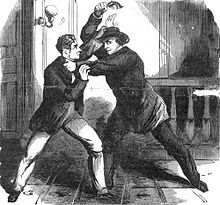Frances Adeline Seward
Frances Adeline Seward | |
|---|---|
 Frances Adeline Seward in 1844 | |
| First Lady of New York | |
| In role January 1, 1839 – December 31, 1842 | |
| Preceded by | Dolly Newell Marcy |
| Succeeded by | Catharine Lawyer Bouck |
| Personal details | |
| Born | Frances Adeline Miller September 25, 1805 Cayuga County, New York |
| Died | June 21, 1865 (aged 59) Washington, D.C. |
| Spouse | |
| Children | Augustus Henry Seward Frederick W. Seward Cornelia Seward William Henry Seward Jr. Fanny Seward |
| Residence | William H. Seward House |
| Education | Troy Female Seminary |
Frances Adeline Miller Seward (September 25, 1805 – June 21, 1865) was the First Lady of New York and the wife of William Henry Seward, a senator in the New York legislature, Governor of New York, a senator from New York and United States Secretary of State under President Abraham Lincoln.
Early life
Frances Adeline Miller was born on September 25, 1805, in Cayuga County, New York. She was the daughter of Judge Elijah Miller (1772–1851)[1] and Hannah Foote Miller (1778–1811), who was born in Williamstown, Massachusetts.[2] She studied at the Troy Female Seminary (now known as Emma Willard School).[3]
Life
Frances was deeply committed to the abolitionist movement. In the 1850s, the Seward family opened their Auburn home as a safehouse to fugitive slaves on the Underground Railroad. Seward's frequent travel and political work suggest that it was Frances who played the more active role in Auburn abolitionist activities. In the excitement following the rescue and safe transport of fugitive slave William "Jerry" Henry in Syracuse on October 1, 1851, Frances wrote to her husband, "two fugitives have gone to Canada—one of them our acquaintance John."[4]
Another time she wrote, "A man by the name of William Johnson will apply to you for assistance to purchase the freedom of his daughter. You will see that I have given him something by his book. I told him I thought you would give him more."[5] In early 1859, the Sewards sold a small piece of land on the outskirts of Auburn to the well-known former slave and activist Harriet Tubman.
Assassination attempt

On April 14, 1865, Frances' husband and three of their children (Frederick, Augustus, and Fanny) were injured in an assassination attempt on her husband in their house.[6] The man responsible was Lewis Powell a.k.a. Lewis Paine, a conspirator of John Wilkes Booth; Booth had shot and killed President Lincoln the same night. The attack put Frances into a state of great anxiety about her family. She thought that Frederick would die of his injuries, although he survived.
Personal life
On October 20, 1824, she married New York attorney William Henry Seward (1801–1872), after meeting him through his sister, a classmate, in 1821. The couple raised five children:
- Augustus Henry Seward (1826–1876)
- Frederick William Seward (1830–1915)
- Cornelia Seward (1836–1837), who died young of smallpox.[7]
- William Henry Seward Jr. (1839–1920)
- Frances Adeline "Fanny" Seward (1844–1866)
Frances died on June 21, 1865, of a heart attack, two months after the assassination attempt.[1] She was buried at Fort Hill Cemetery in Auburn, New York.[8]
In 1870, some years after her death, William formally adopted his companion Olive Risley Seward (1844–1908).
External links
- Seward Family Digital Archive Letters and photographs by and about members of the Seward family.
References
- ^ a b "Death of Mrs. William H. Seward". The New York Times. June 22, 1865. Retrieved September 19, 2016.
- ^ Barlow, Nikita. "Hannah Foote Miller". www.findagrave.com. Find A Grave Memorial. Retrieved September 19, 2016.
- ^ MacLean, Maggie. "Frances Seward". civilwarwomenblog.com. Civil War Women | Women of the Civil War and Reconstruction Eras 1849-1877. Retrieved September 19, 2016.
- ^ Frances Seward to William Seward Oct. 16 [1851] University of Rochester Rush Rhees Library Special Collections
- ^ Frances Seward to William Seward July 1, 1852. University of Rochester Rush Rhees Library Special Collections.
- ^ Doris Kearns Goodwin. Team of Rivals: The Political Genius of Abraham Lincoln (2005).
- ^ Johnson, Patricia C. (Autumn 1978). "University of Rochester Library Bulletin: "I Could Not be Well or Happy at Home . . . When Called to the Councils of My Country," Politics and the Seward Family". University of Rochester Library Bulletin. XXXI (1). Retrieved September 19, 2016.
- ^ "Frances Adeline Miller Seward". www.findagrave.com. Find A Grave Memorial. Retrieved September 19, 2016.
